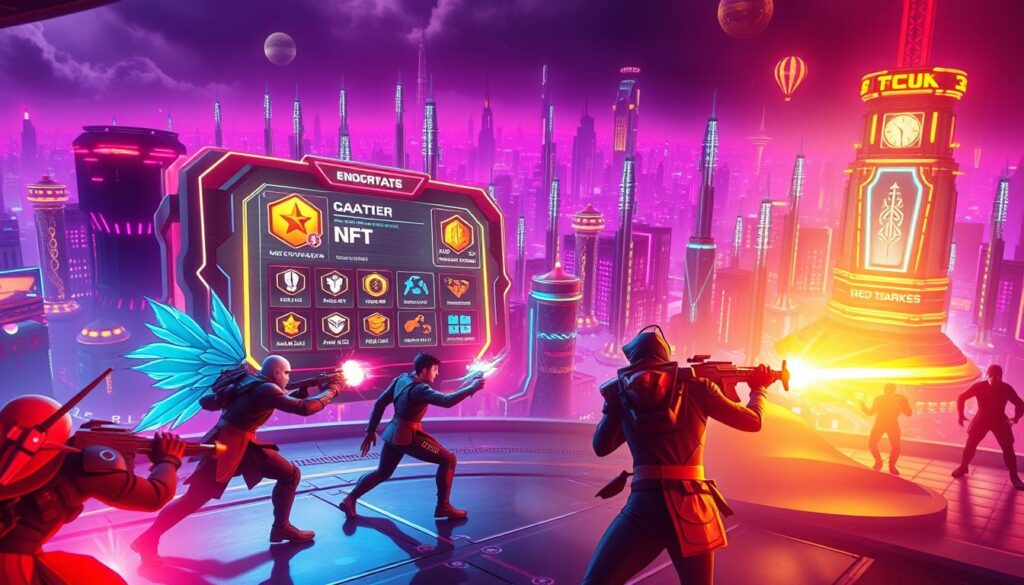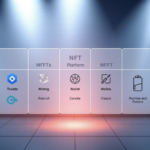Now Reading: Discover How to Earn Royalties from NFT Music Investments
- 01
Discover How to Earn Royalties from NFT Music Investments
Discover How to Earn Royalties from NFT Music Investments

The modern creative economy leaves many artists struggling to profit from their work. Taylor Swift’s high-profile battle to regain control of her recordings reveals systemic issues in traditional revenue models. Even established performers face complex legal hurdles when trying to own their art.
Blockchain technology now offers fresh solutions through transparent payment systems. Justin Blau, founder of Royal, notes that 90% of musicians lack deep knowledge of industry finances. This gap creates opportunities for innovative approaches to compensation.
New platforms let creators retain ownership while generating income from secondary sales. Through tokenized assets, supporters can share in a song’s long-term success. This model benefits both emerging talent and savvy investors.
Current systems often leave artists with minimal recurring earnings. Blockchain alternatives automatically track usage and distribute payments. Fans gain unique ways to support favorite creators while building financial portfolios.
Key Takeaways
- Traditional music industry models frequently disadvantage creators
- Blockchain solutions enable automatic royalty distribution
- Artists maintain ownership through tokenized assets
- Investors access new income streams via secondary sales
- Transparent systems reduce financial misunderstandings
Understanding NFT Music Royalties
Blockchain introduces a new era where creators gain from every resale automatically. This system replaces outdated payment structures with transparent, self-executing agreements. Imagine a world where your favorite song’s success directly benefits its maker for years.
Automated Income Streams Explained
Smart contracts execute payments instantly when digital assets change hands. These agreements typically allocate 5-10% of resale value to original makers. Platforms like Royal and Bolero demonstrate how fractional ownership works, letting supporters claim shares in popular tracks.
Advantages for Both Sides
For content originators, this model offers three key benefits:
- Continuous earnings from growing asset value
- Direct connections with supporters
- Immediate access to funds without delays
Investors enjoy unique opportunities through platforms tokenizing song rights. Through services like Anotherblock, anyone can participate in projects previously limited to industry insiders. Learn more about how these automated payments work in practice.
The technology removes middlemen from payment processes. Real-time tracking ensures all parties see exactly where funds flow. This transparency builds trust while creating sustainable income channels.
The Traditional Music Royalties Landscape
Navigating payment structures in the creative business often feels like solving a puzzle with missing pieces. Each song carries two distinct copyrights – one for the sound recording and another for lyrics/melodies. These split rights mean multiple organizations handle different payment streams, creating confusion even for experienced professionals.

Challenges in Conventional Royalty Systems
Record labels frequently require creators to surrender control of master recordings through binding contracts. Artists receive advances that function more like loans – they only earn after labels recoup marketing and production costs. This arrangement leaves many in debt despite their work generating income.
Payment cycles stretch over months due to manual tracking across radio plays, streaming, and physical sales. Collection societies take administrative fees before distributing remaining funds. A 2022 USC study found only 12% of industry professionals fully understand royalty calculations.
Three critical flaws plague traditional models:
- Delayed compensation timelines
- Opaque financial reporting
- Multiple intermediaries reducing payouts
These systemic issues explain why chart-topping hits don’t always translate to artist wealth. As platforms evolve, creators seek alternatives offering real-time visibility and fairer splits.
Blockchain and Smart Contracts in Music
Outdated payment frameworks crumble as code-driven solutions rewrite financial rules. Blockchain technology acts like a digital notary, recording every transaction in an unchangeable ledger. This shift removes guesswork from compensation models that once favored corporations over creators.
How Blockchain Streamlines Revenue Distribution
Smart contracts revolutionize payment workflows by executing agreements instantly. When a song generates income, these self-operating contracts split earnings according to predefined percentages. Artists receive funds within minutes instead of waiting months for traditional clearinghouses.
Three critical improvements define this approach:
- Real-time visibility into payment calculations
- Automatic splits between collaborators
- Permanent transaction records preventing disputes
Major platforms now bridge legacy systems with blockchain networks. They collect streaming revenue from conventional services before converting it into cryptocurrency payouts. While not fully decentralized yet, this hybrid process demonstrates how non-fungible tokens could eventually bypass middlemen entirely.
The technology’s transparency exposes hidden fees that previously reduced creator payouts. Every participant sees exactly how funds move through the ecosystem. As adoption grows, these systems may become the default standard for fair compensation.
Tokenizing Music: How NFT Platforms Work
Digital collectibles are redefining how creators interact with their audience through verifiable ownership models. Specialized marketplaces transform creative work into tradeable assets using blockchain verification. This shift empowers artists to design unique experiences while maintaining control over their intellectual property.

The Process Behind Music NFT Collections
Creating digital collectibles starts with uploading high-quality audio files to platforms like Sound XYZ. Artists then define collection parameters such as edition size, pricing tiers, and unlockable content. Metadata plays a crucial role, embedding details like songwriter credits and usage rights directly into blockchain records.
Three common tokenization models stand out:
- One-of-one editions: Unique digital originals with premium pricing
- Tiered releases: Multiple access levels with varying perks
- Dynamic assets: Content that evolves based on collector activity
Platforms like Catalog store actual media files on decentralized networks while keeping ownership records on-chain. This approach ensures permanent access even if marketplaces disappear.
Building Token-Gated Fan Communities
Ownership unlocks exclusive spaces where collectors access unreleased tracks or virtual meetups. Artists using Royal often reward early supporters with voting rights on creative decisions. These communities create network effects – engaged fans become brand ambassadors.
Key benefits for creators include:
- Direct communication channels with top supporters
- Revenue from secondary market activity
- Data insights into fan preferences
Platforms like Audius integrate streaming with collectible features, blending traditional listening with Web3 engagement tools. As these ecosystems grow, they offer sustainable alternatives to conventional fan interaction models.
Emerging Trends in NFT Investment Strategies
Digital creators face a critical choice: chase mass streaming numbers or cultivate dedicated supporters. Streaming platforms require millions of plays to generate meaningful income, while token-based models reward deeper connections. A track needing one million streams to earn $4,000 could achieve the same through 100 direct sales at $40 each.
Comparing Streaming Royalties and Direct Sales
Traditional platforms spread earnings thin across passive listeners. Tokenized alternatives let artists monetize superfans directly. This shift creates new market dynamics where engagement often outweighs sheer audience size.
Three factors drive token value:
- Exclusive content or experiences for holders
- Artist reputation and career trajectory
- Community participation levels
Early adopters who bought tokens from unknown artists in 2021 saw returns up to 900% as those creators gained popularity. Platforms now offer diversified portfolios combining established acts with rising talent.
Smart investors analyze price trends and utility features before purchasing. Some focus on limited editions, while others prefer tokens offering voting rights on creative decisions. These market trends reveal shifting strategies for sustainable income.
Risk management remains crucial. Experts recommend allocating funds across different genres and artist career stages. This approach balances potential rewards with market volatility.
Revenue Streams from Fractionalized Music Royalties

Owning a piece of hit songs now operates like stock market investments. Platforms slice revenue streams into tradeable shares using blockchain verification. This lets buyers earn percentage payouts from tracks they believe will grow in popularity.
Three industry leaders showcase distinct approaches:
- Royal focuses on streaming income from artists like Nas
- Anotherblock partners with stars like The Weeknd for specific projects
- Bolero captures broader rights including sync licensing deals
Smart contracts handle payment math automatically. When a song earns $1,000, holders receive amounts matching their ownership stake – often paid in stablecoins. Secondary sales let investors trade shares as track popularity shifts.
Artists keep creative control while accessing upfront capital. The Chainsmokers used this model to fund new work while sharing future revenue. Supporters gain stakes starting under $50, creating accessible entry points.
This system aligns creator success with buyer returns. More streams mean higher payouts for both parties. It transforms passive listeners into active stakeholders, building stronger artist-fan relationships.
Legal, Regulatory, and Copyright Considerations
Legal frameworks struggle to keep pace with digital innovation, creating gray areas for creators and investors. Every song carries two distinct rights – one for recordings and another for compositions. These often belong to different parties, complicating ownership claims in blockchain projects.
Navigating Copyright Law
Clear licensing agreements become essential when tokenizing creative work. Attorney Renata Lowenbraun emphasizes that existing laws require adaptation: “Builders must interpret old rules for new systems until courts catch up.” Platforms face challenges when rights holders disagree about asset distribution.
Three critical issues arise:
- Potential securities classification by regulators
- Jurisdictional conflicts in global markets
- Enforcement of off-chain copyright claims
Smart Contract Limitations and Best Practices
While automated contracts handle payments efficiently, they can’t resolve legal disputes. A smart contract might split royalties correctly but can’t stop unauthorized sampling of melodies. Platforms integrating loyalty programs must clarify what buyers actually own.
Key strategies for compliance:
- Document all licensing terms in traditional agreements
- Disclose regulatory risks to participants
- Consult legal experts across operating regions
The industry needs standardized practices as governments develop clearer guidelines. Until then, transparency remains the best defense against legal challenges.
Leveraging New Technology for Sustainable Music Revenue
Creative industries are witnessing a tectonic shift as specialized tools bridge the gap between art and commerce. Visionary platforms combine blockchain capabilities with fan engagement features, offering creators smarter ways to monetize their work. This evolution marks a turning point for sustainable career models in entertainment.
Innovative Platforms Shaping the Future
Marketplaces like Sound XYZ and Audius demonstrate how new technology transforms content distribution. Sound’s recent $20 million funding round, backed by industry leaders, highlights growing confidence in these solutions. Their systems integrate with streaming services to trigger automatic payments when tracks gain traction.
Three features set these platforms apart:
- Dynamic assets adapting to real-world milestones
- Cross-platform compatibility with major streaming apps
- Customizable revenue splits for collaborators
General marketplaces now face competition from specialized alternatives. Artists could previously struggle with generic tools, but platforms like Royal offer tailored dashboards tracking both sales and streaming data. This dual approach helps creators build lasting income without sacrificing creative control.
As these systems mature, they create blueprints for fairer digital economies. The fusion of Web3 capabilities with traditional distribution channels points toward a more equitable future for content originators worldwide.
FAQ
How do blockchain-based systems improve revenue sharing for creators?
Blockchain automates payment splits through code, ensuring instant and transparent payouts whenever content is sold or streamed. This eliminates delays and middlemen in traditional systems.
What advantages do token-gated communities offer musicians?
Token-gated platforms like Audius allow artists to offer exclusive perks—early song access, concert tickets, or behind-the-scenes content—to fans holding specific digital tokens, deepening engagement.
Can smart contracts fully replace legal agreements for royalties?
While smart contracts automate transactions, they can’t address complex copyright disputes. Platforms like Royal recommend combining them with legal frameworks for full protection.
How do direct sales compare to streaming income for independent creators?
Selling limited-edition tracks on marketplaces like OpenSea often generates higher upfront earnings versus micro-payments from Spotify, though both models can coexist for diversified income.
What risks come with fractionalized ownership of creative work?
Splitting ownership into tradable tokens increases liquidity but requires clear terms to avoid conflicts. Platforms must define profit-sharing rules and usage rights upfront.
Which platforms lead in merging Web3 tech with sustainable income models?
Services like Sound.xyz and Catalog focus on eco-friendly blockchain solutions while enabling artists to earn through primary drops and recurring secondary market commissions.
How do copyright laws adapt to decentralized content distribution?
Organizations like ASCAP now track blockchain registries, but global standards are evolving. Creators should register works with agencies and embed licensing terms in digital assets.
Why are secondary sales significant for long-term earnings?
Built-in resale commissions (e.g., 10% on each resale via platforms like Foundation) let creators profit continuously as their work gains value—a feature absent in traditional deals.















